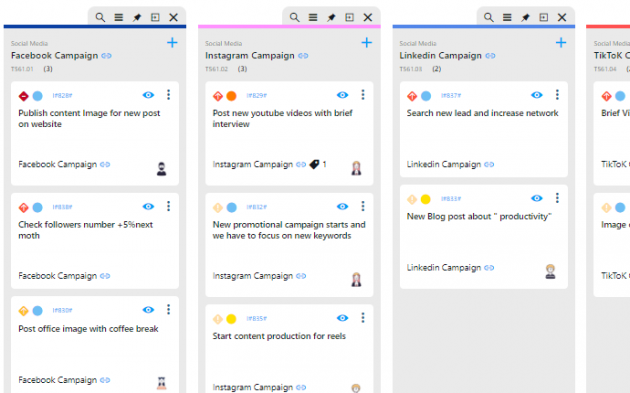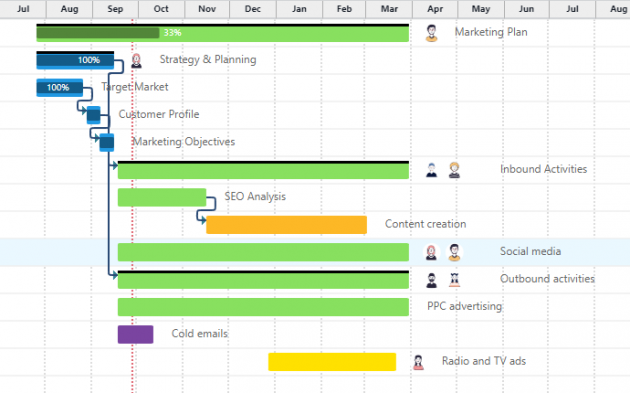Agencies operating in the marketing sector, which today is almost entirely digital marketing, are at the centre of a growth trend that will persist in the coming years.
The consequences of this growth are increased day-to-day challenges in managing complex teams and projects in an increasingly competitive market.
TABLE OF CONTENTS
- How to increase creativity and productivity in a marketing agency
- Objective #1: Distribution and monitoring of activities in marketing agencies
- Solution #1: Organising activities in shared notice boards
- Solution #2: Convenient and flexible timesheets
- Objective #2: Analysis of marketing campaign progress
- Solution #1: Gantt chart for analysing progress and results
- Solution #2: Unified time and cost management to prevent management errors
- Guaranteed flexibility and agility in marketing project management with Twproject
As the industry becomes more specialised and diversified, marketing agencies are faced with complex tasks with tight deadlines and at the same time need to keep their creativity alive and indeed enhanced.
Projects in this area are usually relatively small, but they are many and varied, designed for clients with very customised needs.
Managing numerous customers and activities forces one to rethink strategies in order not to reduce productivity while dealing with so many work aspects at the same time.
How to increase creativity and productivity in a marketing agency
Several strategies can be implemented to increase productivity at work.
The first may seem trivial and yet many project managers forget to put it into practice. It is first and foremost a matter of ‘setting goals’.
With the experience gained from talking to our digital marketing clients, we will help you identify which goals to keep in mind when managing projects and how to achieve them.
The common goal of all the objectives that we will identify and analyse will always be to streamline processes in order to promote time for creativity, which remains the main, and crucial, goal to pursue.

Objective #1: Distribution and monitoring of activities in marketing agencies
When the team works on many different projects, it is crucial to find ways to centralise communication and simplify collaboration among the players.
Communication must become lean and agile, so as not to interrupt the workflow and to keep the level of creative flair high.
If the list of tasks to perform is clear and defined, one can proceed in a much more confident and expeditious manner. If, once the assigned tasks have been completed, employees can note down the work and the time spent on it quickly and accurately, team management will be much more rewarding.
Solution #1: Organising activities in shared notice boards
An optimal way to make communication more agile and immediate, with real-time updates and feedback, is to divide activities into micro-tasks and distribute them through tools such as the Kanban board.
The Kanban board is a kind of virtual noticeboard that allows members of a marketing team to be involved from start to finish in campaigns.
This board consists of individual activities, called To-Do’s, which represent the elements to be distributed within the board among the various collaborators.
Each To-Do has a set of data, such as title and description, but also priority, status, reference project, category, comments and so on.
An excellent example of a Kanban board is that of Twproject, which in addition to possessing all the features already listed, has great flexibility and allows elements to be displayed according to various sorting criteria.

The Kanban board is very suitable for the management of marketing campaigns because it allows a simultaneous view of all campaign data and information and aligns the work between the parties.
In this way, each collaborator is able to know what phase of the project he or she is involved in and what tasks have been assigned to him or her.
The project manager sorts and distributes the tasks, placing them on the board and adding details and information. The assignee can comment and reply, change the progress status and keep track of every detail.
If you choose to use Twproject for this method of allocating and monitoring tasks, your workflow will be dramatically improved and streamlined.
Solution #2: Convenient and flexible timesheets
The work of the digital creator is made up of many different activities, precise and targeted interventions alongside structured operations and longer conceptual work.
It is therefore never easy to keep track in a single day of how much has been done, for which client or project. Worse still when one has to report on work over longer periods of time.
But accurately monitoring the hours worked on client contracts is a key task for marketing agencies.
When each co-worker uses his or her own systems to keep track of the work done, reporting this work to the client is a very difficult task for the project manager.
On the other hand, the use of unified time-reporting systems ensures effective coordination and control, for both internal and external use.

But if you want to give each team member the opportunity to report in a customised manner, also depending on the type of work performed at a certain stage, it is important that the chosen system is flexible.
A good model for flexibility in the recording of hours worked is Twproject, which offers multiple methods of reporting: from the weekly timesheet, to the time tracker that can be activated directly on project phases or activities, and also the direct entry on completed tasks.
Twproject provides us with an efficient solution for monitoring project progress and recording hours worked, saving both costs and energy.

Objective #2: Analysis of marketing campaign progress
Strategy definition is the key element of all marketing campaigns, be they digital or otherwise.
However, it is not always easy to communicate the strategy and, above all, to convert it into clear objectives for all those involved, and perhaps with the addition of timelines and deadlines.
For a project manager in marketing, as we have already explained in the section on the Kanban board, it is useful to equip oneself with visual tools that transform the theoretical idea into an illustrated prospectus to be shared with the parties involved.
Once this prospectus has been defined, we can more easily monitor progress and analyse the data obtained, even correcting errors on timings and budgeted costs.
Solution #1: Gantt chart for analysing progress and results
A tool that is not always appreciated by project managers in marketing agencies, but which we strongly recommend is the Gantt chart.
This visual tool allows you to put down on paper all the elements to be kept under control and predict the duration of implementation.
When the schedule of a project, such as the launch of a new product, is planned using a Gantt chart, it is much easier to keep track of progress and monitor ongoing activities and their deadlines.
The Gantt chart developed by Twproject helps to manage time consciously through a simple interface.

It allows for a customisable view on a macroscopic level as well as on individual details.
It also offers functionality to review data at the end of the project and to know when and how any errors in cost forecasting or schedule planning occurred.
With Twproject, the project manager has the possibility to reuse this data to set more accurate timelines in future projects.
Solution #2: Unified time and cost management to prevent management errors
If monitoring the work done and having a clear overview of the progress of projects is therefore crucial in a marketing agency, so is being able to convert this performance data into a financial statement.
The need for monitoring expenses in marketing agencies can be twofold, encompassing both the costs of projects for the company itself and the costs of campaigns for clients.
In both cases, the unified management of timing and costs is a fundamental requirement for marketing projects. The relationship between campaign costs and their performance is a crucial aspect and is not always linear and easy to define.
The advice is to always keep time control and cost monitoring aligned.
Rescheduling certain dates if necessary, taking into account possible project variations, must always be accompanied by budget change forecasts.
Twproject does this automatically, having merged its statement of project phases and timelines with the financial report.
Any change in time is converted into a change in cost, which is promptly notified to those in charge of managing the work.
If budgets and deadlines are carefully planned from the beginning of campaigns, it will then also be easier to reconstruct and justify any cost variations to be communicated to the customer.
This last analysed point also helps to streamline processes and make daily work easier for both the project manager and the whole team.
Guaranteed flexibility and agility in marketing project management with Twproject
If we were to identify a constant in digital marketing projects, it is the great diversity of them. Even within the same agency, projects and related activities are always very diverse in terms of type and method of execution.
It follows that great flexibility of approach is needed in this area, and consequently tools are needed to manage very different projects (and teams).
Twproject is precisely that flexible and customisable tool: it has functionalities that are suitable whether one is conducting advertising campaigns, handling a product launch or creating digital content.
In all cases, it helps to accurately plan and evaluate the work done and to formulate precise budgets for the future. It does this, however, by streamlining the time spent on work organisation and monitoring activities, leaving room for creative work.
With Twproject you only have one platform where you can organise activities, schedule timings and manage resources.
Want to see how it works first hand? You can take a 15-day free trial where we will help you set up the work according to your needs and strategic goals.




